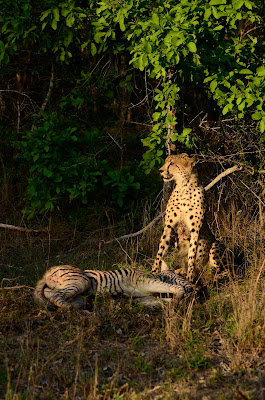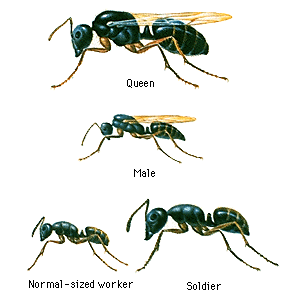This may seem
like a strange subject to write about, but it was prompted by a question a
guest asked me on game drive one day, and that was “What happens to termites
when they die?” I recall pulling my “hmmm good question face”… and I thought to
myself, what DOES happen to termites when they die? Do they only die outside
the termatorium? Do predators outside the mound just eat all dead termites?
Bearing in mind that a single colony can support hundreds upon thousands of
individuals with a short life span, the death rate must be pretty high.
 |
| Colony of fungus growing termites |
Completely
intrigued, I did some research, and was most surprised by the results.
Scientific papers dating back to 1958, entitled the likes of “The undertaking
activities of social insects”, “Corpse Management of social insects”,
“Differential undertaking responses of a lower termite to corpses.”…The list
was endless. I read through a number of these papers and sat back in my chair
by the end to mull results over. I played out a scenario in my head of a
termite dying, a second individual finding it, and a third termite rushing up
and stating aloud “move over, I am the undertaker”. I laughed out loud, but
actually, that is exactly what happens.
To maintain
healthy colonies, social insects, i.e. bees, wasps, ants and termites have
evolved sophisticated ways to counter the threat of disease at both the
individual and colony level.1 Any nestmates that die inside the nest
represent a high risk for insect societies, especially those that have died due
to some infectious agent2. All possible measures are thus taken to
prevent potential sources of diseases from spreading to other members of the
society, especially the queen and the brood. The nature of these insects allows
for the specific division of labour in their social structures, in the sense
that different individuals engage in very specialised tasks. This has lead to
the development of an “undertaker worker” that exists for the purpose of
engaging in corpse management and must quickly remove all the dead members of
the colony inside the nests1. Bees, wasps, ants and termites are the
only animals apart from humans that harbor complex behavioral strategies for
disposing of dead belonging to their same species.
 |
| Termite caste system |
So what does
happen to social insects when they die? Honeybees, ants, and termites each show
species-specific undertaking responses toward corpses (see Figure 1).
 |
| Figure 1. |
Studies of
undertaking behavior in bees have traditionally focused on the honey bee3.
Honeybees dispose of nestmate corpses in a straightforward manner, i.e, corpse
removal4. An “undertaker” bee typically antennae’s the dead bee
briefly, grasps its appendages with mandibles, transports it outside, and drops
it from the hive. Noteworthy is that other debris in honey bee colonies have
been observed to be removed less rapidly3.

The behavioral
patterns of ants are extremely diverse, but they are known to keep the interior
of their nest meticulously clean. Corpse removal is common in various ant
species, and is distinguished from other nest cleaning behaviors as corpses are
transported more rapidly and over greater distances than inanimate objects5.
Cannibalism of dead individuals was observed in some species, and the Matabele
ant, for example, eat their defeated enemies after intercolony battle6,
which has been considered to be adaptive as they practice cannibalism behavior
more frequently during period of food shortage7. Besides
cannibalism, ants are reported to perform burial behaviors using soil and nest material
in response to corpses8 but it is less common probably because the
energy input of burial activity is higher than corpse removal9.
 |
| The undertaker ant...removing a dead nestmate |
Termites too have
evolved complex systems of corpse management dealing with corpses of different
ages, origins, and infection status.1 They include burial, avoidance, and
cannibalism. Cannibalism of the dead in termites is considered to be a
mechanism of recycling nitrogenous nutrients10, which is, in part,
due to their nutritionally poor cellulosic diet11. In comparison to
ants and bees, termites preference for tunnel building plays an important role
in their burial behavior12. In fungus-growing species, the existence
of corpses induces building behavior to separate the dead from the rest of the
colony. The use of fecal material, chewed material or soil coated with saliva
for building (and burial) provides antifungal components that act as further
protection against fungal growth and spreadable diseases.
 |
| Termite workers and soldiers |
It is one thing
accepting undertaking activities, but how do these insects, some who don’t even
have a brain (only a central nervous system), even know that their nestmate is
dead? Research suggests that death recognition is a combination of factors, but
in particular can be explained by two hypotheses: a “fatty acid death cue” and
a “chemical vital sign”13. Fatty acids are released upon death for
decomposition, but where corpses are found and removed within one hour (which
is too short a time period to allow for decomposition), it has been suggested
that the absence of a chemical associated with life may prompt undertaking
activities14.
 As a result,
these social insects exhibit specific responses to the nature of the corpses,
including their postmortem time, infection status (whether harmful fungi are
present), and origin (whether or not the corpse is a nestmate or of the same
species). Responses then vary from removal, burial or cannibalism. Fungus
growing termites, for example, were found to isolate fungal infected
individuals by burying the dead onsite, while the healthy corpses were
cannibalised15. Soldiers were also involved with guarding corpses as
the burial response was underway. In honeybees, 1h old corpses were observed to
be removed more quickly than freshly killed individuals3, and dead
ants of the species “Red wood Ant” were consumed for food, but infectious ants
were avoided16. In another species, workers discriminated old
corpses from freshly killed individuals, with new corpses buried while old ones
are transported outside17.
As a result,
these social insects exhibit specific responses to the nature of the corpses,
including their postmortem time, infection status (whether harmful fungi are
present), and origin (whether or not the corpse is a nestmate or of the same
species). Responses then vary from removal, burial or cannibalism. Fungus
growing termites, for example, were found to isolate fungal infected
individuals by burying the dead onsite, while the healthy corpses were
cannibalised15. Soldiers were also involved with guarding corpses as
the burial response was underway. In honeybees, 1h old corpses were observed to
be removed more quickly than freshly killed individuals3, and dead
ants of the species “Red wood Ant” were consumed for food, but infectious ants
were avoided16. In another species, workers discriminated old
corpses from freshly killed individuals, with new corpses buried while old ones
are transported outside17.
So next time you
see one of these social insects, or drive past their colonies, keep an eye open
for this intriguing behavior, and you never know, one day you may even meet
“The Undertaker”.








